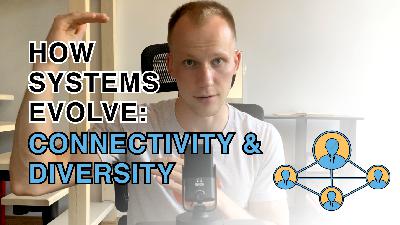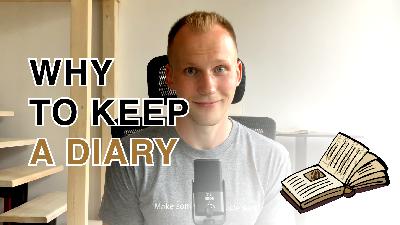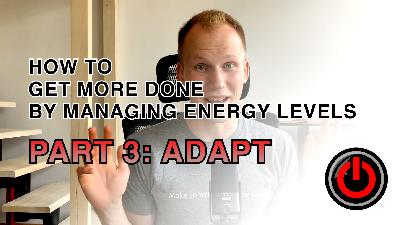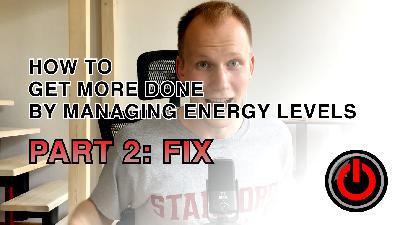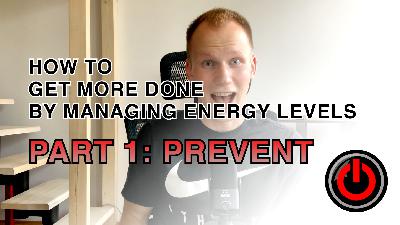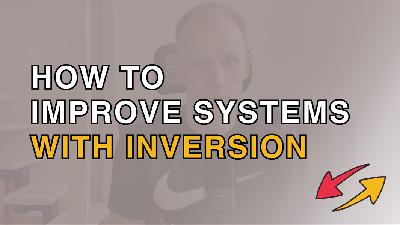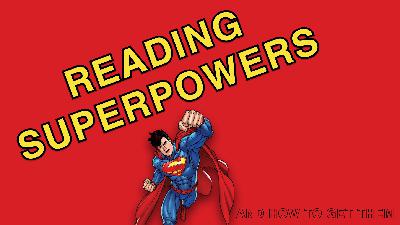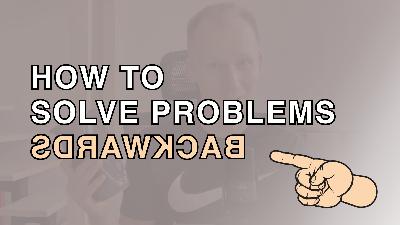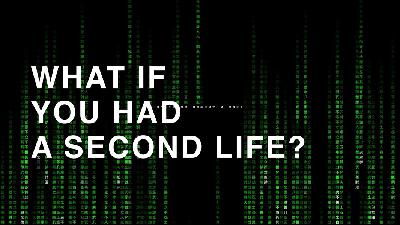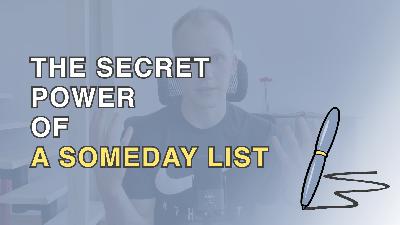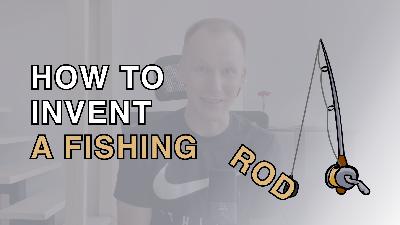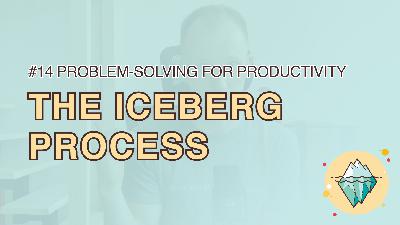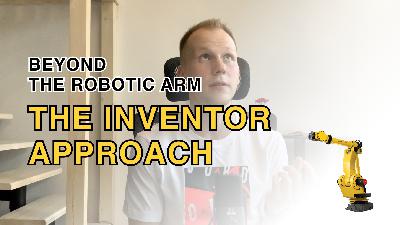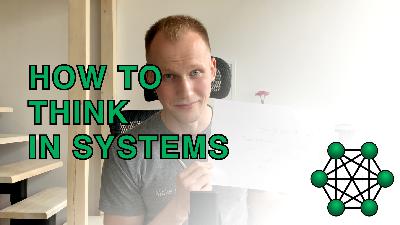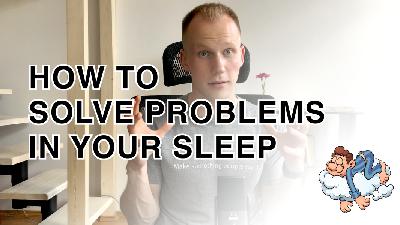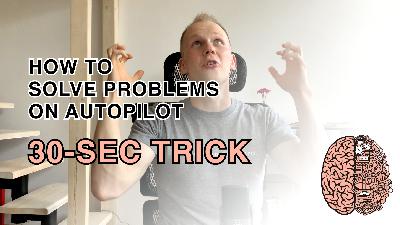Discover The Daily Recall
The Daily Recall

The Daily Recall
Author: Vasili Shynkarenka
Subscribed: 3Played: 29Subscribe
Share
© Vasili Shynkarenka
Description
Hi! I’m Vasili, the guy who runs the show. I believe the world would be a better place if you learned something new every day. That’s why I record daily episodes where I explain complex ideas in simple words. I hope you’ll enjoy the show.
thedailyrecall.substack.com
thedailyrecall.substack.com
29 Episodes
Reverse
Hey friend,In this episode, I explain two principles you can use to improve any technical system and show how similar are a pack pencils, a paragraph of text, Amazon book store, and a web page.There’s no transcript for this episode, so either give it a listen or watch the video version here.Happy Wednesday,-Vasili This is a public episode. If you would like to discuss this with other subscribers or get access to bonus episodes, visit thedailyrecall.substack.com
Hey friend,In this episode, I explain how to write a diary that your future self will benefit from having.There’s no transcript for this episode, so either give it a listen or watch the video version here.Enjoy your Tuesday,-Vasili This is a public episode. If you would like to discuss this with other subscribers or get access to bonus episodes, visit thedailyrecall.substack.com
Hey friend,In this episode, I explain my system of language learning that can help you start thinking in English instead of translating.If you prefer watching, you can find the YouTube video here. If reading is your thing, then enjoy the transcript below.Welcome to The Daily Recall show. I'm your host, Vasili. Today you will learn one simple trick that can help you become a native English speaker.I think that most people think about language learning wrong. They start taking classes, read text books, and go to English clubs. That’s how you can get some baseline but it won’t help you to become a native speaker. You keep translating stuff in your head.Real language learning comes down to one simple metric; how many times you think thoughts in a language that you're trying to learn. And the key to learning English - and any language - is to optimize for this metric as much as you can. This optimization boils down to a simple question - how many times a learning method prompts you to think in English. Traditional learning methods don’t offer much on this front. If you sit in a class with twenty other dudes and occasionally raise your hand, that’s not how you get many opportunities for thinking in English. And you have this torturous homework to deal with.Here're some better methods:* Start taking notes in English; this will prompt you to think in English each time you need to write something down* Write a diary* Change your default phone language to English* Read books* Watch movies* Get a job where you have to communicate in EnglishWhenever you don’t understand a word, don’t look for a translation. Try to understand what it means from the context or go ahead and read the definition of this word from the vocabulary. But do not translate; that’s how you keep building this habit of thinking through translating that prevents you from becoming fluent.To recap -Language learning comes down to how many times you think in the language that you're trying to learn. The best way to learn a language is to design an environment that prompts you to think in this language. This approach is way more efficient than any other approach out there because it naturally integrates into your life. When you take an English class three times a week, that thing is actually artificial, and your nature will fight against that. But if you integrate these thinking prompts as routines into your daily life and keep them simple, you will do great.Thanks very much for reading and see you tomorrow.This transcript has been edited for clarity. This is a public episode. If you would like to discuss this with other subscribers or get access to bonus episodes, visit thedailyrecall.substack.com
Hey friend,In this episode, you will learn how to start reading 1.8k books a year by spending just 25 minutes a day.If you prefer watching, you can find the YouTube video here. If reading is your thing, then enjoy the transcript below.Welcome to The Daily Recall show. I'm your host, Vasili. Today you will learn how and why to read five books a day. When most people think about reading, they think of taking a book, diving in, struggling to figure out what the author is talking about, etc. When I think about reading, I think of it backwards from the purpose of the process. The purpose of reading is learning. This means that it doesn’t matter how many books you read; the only thing that matters is how much you learn from them. The quality of your learning depends on the quality of the material you learn from. Given your reading capacity of 10 books per year and five million books out there it's really dumb to read from cover to cover; you need more options to choose from.My approach is to scroll a bunch of books every day and read for understanding only what sparks my curiosity. It takes a few minutes to understand if a book is interesting enough to keep reading it; and you can do that by downloading a free sample from Amazon - no need to buy a bunch of books. And you can do that in a car, when waiting in line, etc. Remember - you're not learning yet. Curiosity works differently than understanding; it's like seeing a girl for the first time. You either like her or not; you don’t think about that proactively - "oh is she pretty or not?"Here's some math. It takes 2-5 minutes to scroll a sample of one book. 20 minutes a day. This gives you 1.8k books in a year to choose from instead of 10 that you'd otherwise read cover to cover.Thanks for reading and see you tomorrow.This transcript has been edited for clarity. This is a public episode. If you would like to discuss this with other subscribers or get access to bonus episodes, visit thedailyrecall.substack.com
Hi friend,In this episode, you will learn how to adapt to having no energy and win the time back by doing low energy work that has to be done anyways.If you prefer watching, you can find the YouTube video here. If reading is your thing, then enjoy the transcript below.Welcome to The Daily Recall show. I'm your host, Vasili. This is the last day of a three-day series on how to get more done by managing your energy levels. In Part 1: Prevent, I explained how to prevent the problem from happening in the first place; how to always have a ton of energy. In Part 2: Fix, I outlined what you can do to get your energy back during the day.Today I will cover how you can adapt to this problem if you're not able to fix it.When you're in a low energy state, you can still do work. And the best thing you can do is to take care of things that you have to do anyways. Buy groceries. Take the trash out. Clean up your place. Because that’s how you can win the time back. If you have to do this work anyways, then by doing it when it matches your lowest energy state you're actually winning back time because you won’t have to deal with this stuff in the future when you will have lots of energy. But there’s a problem. When you find yourself in a low energy state, it's hard to figure out what kind of things you can take care of because you can’t think well. You need to have already thought.I recommend you keeping a "brain gone" list of things you can do when you find yourself in a low energy mode. Stuff like: process invoices, take the trash out, do house cleaning, do groceries - anything that doesn’t require energy but has to be done. Another option would be to do nothing. Rest. It's always a great option. You also get to recharge your mind by doing that and you will have more energy tomorrow. To recap - If you find yourself struggling with having no energy during the day and Part 2: Fix advice didn’t help, then you need to adapt. Take care of the low energy work that has to be done anyways. This will enable you to win the time back because when you get to a high energy mode again you won’t have to waste precious time on doing this low energy stuff.Take care and have more energy!This transcript has been edited for clarity. This is a public episode. If you would like to discuss this with other subscribers or get access to bonus episodes, visit thedailyrecall.substack.com
Hey friend,In this episode, you will learn what to do if you find yourself having no energy during the day and need to recharge.If you prefer watching, you can find the YouTube video here. If reading is your thing, then enjoy the transcript below.Welcome to The Daily Recall show. I'm your host, Vasili. Today is the day two of our three day series on how to get more done by managing your energy levels. Yesterday, I covered how to prevent the problem from happening in the first place. You can do that by asking the opposite question, what should you do to have no energy at all, and then flipping back the answers. Then you can work through that list to always have high energy state.But s**t happens. You will have travel and just "bad days". So what should you do to get unstuck and return to your productive state?The first step is to realize that you’re stuck. This is what I struggle with the most. It's really hard to understand when this is happening to you and distinguish being stuck from just not being able to solve a problem or work on a task at hand. That’s why it's good to have metrics and take notes. Whenever I start on a big task, like writing a post, I write it down - "11:05 pm - started writing a draft for my stay fit for life essay." Not only this helps to deal with procrastination through intention design and micro planning (people who write down their plans for next hour are 20-30% more likely to stick to them) but it also provides a time parameter that I can use to realize if I’m not moving forward. So if I find myself working on something for longer than 10 or 15 mins and not making any progress and mind starts feeling foggy, that's a good sign that I might be entering - or have already entered - a low energy territory. And if I start feeling foggy or physically uncomfortable then it's also a good indicator. The second step is to run a procrastination check-up.Very often what I think is low energy mode is actually "don’t know how to do this s**t" mode. A good way to check yourself is to set up a timer for 10 mins and promise yourself that you will stop doing the thing after 10 mins if you feel just as bad. Timer works because procrastination arises from an area of your brain called the insular cortex which highlights whenever you get to do (or even think about doing) something unpleasant or hard. So it's always a good idea to check yourself for procrastination first - and this actually trains yourself to be more persistent and gamifies the problem; instead of thinking "oh I gotta finish this assignment by tomorrow" you start thinking "how much of it I can do in ten mins if I can stop after ten mins anyways?"But if you’ve gone through both steps - identified that you’ve been sitting here not making progress for twenty minutes and did a procrastination 10 mins checkup - and the problem is still there; now it's time for big guns.The first thing you need to do after identifying the problem is to accept it. This is hard because acceptance lowers your ego. One thing that helps is knowledge; if you know that you're not accepting yourself being a failure and not knowing how to solve this but actually accepting the way your body and mind works, then it's way easier to do it. And acceptance is important because otherwise you'll not be able to solve it. You'll be sitting at your desk for hours and trying to break a brick wall by hitting your head against it over and over again.There are three things you can do to fix this state:* First, just go out for a walk. This is what I do whenever I find myself struggling during the day. I stop doing whatever I’m doing, stand up, get my shoes on, and just go for a 10 to 20 min walk. This change in the environment helps to switch your thinking modes; from the focused mode (when your neurons are really close to each other) to the diffuse mode (when you're not thinking about anything in particular). Another aspect of it is to get some sun exposure; I don’t know how exactly it works but getting out of the building and walking to some small park nearby and enjoying the sunshine and fresh air for five minutes does wonders (look up Japanese forest bathing phenomena if you’re interested). One things that helps here is to not change your clothes and be always ready in 30 seconds to go out; if you make it easy for yourself to take a walk, you will do it more often.* Second, do the coffee-nap-shower combo. Fix yourself a double espresso, take a 40 mins nap, and take a cold shower right after you wake up. Works like magic for me whenever I’m traveling or had insufficient sleep for some reason. I fix myself a cup of strong espresso (>= 2 shots) and also have two or three pieces of 100% organic Ecuador Venchi chocolate. Then I immediately go for a nap. I fall asleep for about 40 to 60 minutes (get some eye mask or ear plugs if you need them) and then I wake up right after the caffeine starts working. And then I go ahead and take a contrast shower to impose some short-term stress on my body. * Third, workout. I do a 30-50 min HIIT workout and it does wonders. So whatever works for you - running, HIIT, etc. - anything of high intensity to pump up some blood will be incredibly useful here.Just to recap -Realize that you're stuck, check up for time effort and procrastination, accept the problem, and deal with it. Go for a walk, do the coffee-nap-shower thing, or workout - whatever you prefer. But don’t let you precious high energy time slip.Tomorrow, I will explain how to win your time back when this stuff doesn’t help.Take care,VasiliThis transcript has been edited for clarity. This is a public episode. If you would like to discuss this with other subscribers or get access to bonus episodes, visit thedailyrecall.substack.com
Hey friend,In this episode, you will learn how to prevent the problem of having no energy to do great work.If you prefer watching, you can find the YouTube video here. If reading is your thing, then enjoy the transcript below.Welcome to The Daily Recall show. I'm your host, Vasili. Today you will learn how to get more done by managing your energy levels. In the past couple of decades we’ve come to work from anywhere and anytime. Location and time are not the constraints anymore. You always have internet access and can do great work from your phone. The problem is lack of energy. The best way to approach the energy problem is to prevent it from happening in the first place. To always have lots of energy.Let’s think backwards and ask the opposite question:What should you do to have no energy at all? The question itself is more useful than any advice you will pick up from this video. Because you can apply it to yourself instead of picking up stuff that worked for me.For example, if I tell you to wake at five am every morning to have more energy, that’d be a terrible advice. Because I have no idea what your circadian rhythm is. And if you’re a late person and begin waking up early, you'll be fighting your own biology. But if you ask yourself this inverted question, then you'll figure out a bunch of things that make you less energetic and then you can work through that list to prevent them from happening. It's that easy.Anyways, I will share a list of energy suckers that you might find yourself struggling with as well. Just don’t take it for granted and always think for yourself before applying this advice.So what should you do to have no energy at all to perform great work?* Do work that you hate doing. If you just follow this advice, I guarantee you will have no energy at all. You will procrastinate all the time. So that’s a good start.* Eat badly. If you screw up your nutrition, you will screw up your energy levels. So just eat the stuff that makes you feel terrible the next day. Drink too much alcohol. And you will have no problem at all with having no energy.* Never exercise and never do any physical activity of any kind. Just sit in your chair all day long. That’s a great way to have no energy because if you do not impose short term stress, which is called hormesis, on yourself, then your muscles deteriorate over time. And that’s how you come to have no energy because your physiology is connected to how much energy you have. So that’s a good one as well; never exercise.* Sleep badly. You have probably noticed this for yourself. If you have a couple nights of insufficient sleep, then you quickly realize how screwed you are. You can’t lift a finger without filling yourself with coffee.* Drink too much coffee. If you drink 5 or 7 cups a day, your energy levels will be unstable. You will always feel either pumped or drained. So if you want to have no stable high energy levels, just drink too much coffee.* Always be worried, anxious, and emotionally unstable. For example, you had a really intense conversation with your girlfriend last night. And now you keep thinking about this stuff all day long. And instead of writing the thing down to deal with it later you keep coming back to this thought over and over again. Purging your working memory. That’s an especially good one because you will have no focus as well.* Always do deadline-based work and keep your calendar full of meetings. Working under a deadline imposes constant stress on you so you will have no problem with having no energy. * Never write anything down. Have the same thought over and over again. That’s how you easily get to zero energy levels because your working memory will be overloaded with all this stuff that's flowing at you. You will end up having no good thoughts and will be stressed all the time because of all this cognitive load that comes through your head. * Never decide. Whenever you not decide on any decision that is right in front of you, you actually decide to not decide. Psychologists call this decision fatigue. And the more you keep snoozing the decision, the more energy it will suck up from you. Just to recap - The best way to solve the energy problem is to prevent it from happening. You can approach this problem by asking the opposite question - what should you do to have no energy at all. When you get your answers, just flip them back - ie a negative prescription "sleep badly to have no energy" turns into a positive advice of "get sufficient sleep to have stable energy levels during the day." Enrich this list by adding more things that make you energetic and you'll be ready to deal with this energy problem by preventing it.Tomorrow, I will cover how to fix the energy problem. It's 3:07 pm and you find yourself in a "brain gone" mode - what should you do to fix that state and come back to your high performance mode?See you tomorrow!This transcript has been edited for clarity. This is a public episode. If you would like to discuss this with other subscribers or get access to bonus episodes, visit thedailyrecall.substack.com
Hi friend,In this episode, you will learn how to discover new knowledge by looking for principles behind the facts and leveling up through the knowledge tiers.If you prefer watching, you can find the YouTube video here. If reading is your thing, then enjoy the transcript below.Welcome to The Daily Recall show. I'm your host, Vasili. Today you will learn how to discover new knowledge by identifying principles behind the facts.I’ll begin with a story.Yesterday morning, I was standing in line to grab my coffee. There was a girl in front of me getting a cappuccino with almond milk. She was staring at a blueberry cake behind the glass and smacking her lips. There were many blueberry cakes, some chocolate ones, and one piece of carrot cake left. But the waitress was smart. She said: "Oh you know we’ve got this very last piece of carrot cake left - would you like some?" The girl grabbed the bait and went to enjoy her morning coffee with the last piece of carrot cake. That's an example of a fact you can pick up from the world. You get to see many such things during the day - and you can also read them in books or hear in a conversation. But when you make an observation like that - that the girl changed her mind when the waitress told her about the very last cake left - the very next thing you should do to discover new knowledge is to ask is there any principle behind this fact. In my carrot cake story, she decided for some reason to change her mind and go for this carrot cake instead of of other options. Why did she do that? By answering this "why" question about why something happened, you get to uncover a principle; that people are more willing to purchase something when less is available. Scarcity increases perceived value by suggesting the popularity of an item. So whenever you see something - the last movie ticket left or the last piece of carrot cake - you’re tempted to buy it because of the fear of missing out and because of the increased perceived value of an object - ie "this stuff must be good if they sold everything!" (For those folks who know economics - there are other reasons as well but I keep it simple here)That’s how you level up to the principle behind the fact. This conceptual knowledge is way more interesting because you can start thinking - "ok I’ve got this carrot cake thing but are there any other applications of the principle?" You get to think for yourself instead of picking up facts from someone else.Principles are also easier to remember because they swallow facts. Whenever you uncover a principle behind the fact; the fact becomes just a part of it. This means there are other applications of this principle in the world. And whenever you stumble upon one, you'll get to remember the principle as well and enrich your understanding of it. But let’s come back to our carrot cake story.Once you’ve got the principle, you can start climbing up the knowledge ladder. Because when you realize that scarcity impacts purchasing behavior you can’t help but start thinking about other things that influence purchasing behavior as well. You go up a little bit and ask: "ok I’ve got this scarcity principle but are there any other things that impact how people buy stuff?" That’s how you can easily arrive to understand the price-value idea; that people treat expensive goods as higher quality ones even thought most of the times this is not the case at all. This principle drives a lot of purchasing behavior in humans. And then if you put two and two together, you can understand that by producing tremendously overpriced scarce goods we can actually have a good business because that’s how people buy stuff - think of Rolex or Bentley here.But you can go up even more. Just ask: "hey this is how people buy stuff but buying is just one of the decisions that we make in life right?" - and you will arrive to a whole new land of what determines how humans decide in general. Humans decide to sell things. Humans decide to marry other humans. Humans decide to fire people, to hire people - there are thousands of different decisions that we make. And you can jump back and forth between levels and enrich your understanding and grow your conceptual knowledge that way.Just to recap -You stumble upon knowledge gems every day. But gems don’t come as diamonds; they’re unpolished and dirty when you first discover them. Your goal is to always look for principles behind the facts and level up your conceptual knowledge tiers. That’s how you get to discover new knowledge and think new thoughts.Thanks for reading and enjoy your week!This transcript has been edited for clarity. This is a public episode. If you would like to discuss this with other subscribers or get access to bonus episodes, visit thedailyrecall.substack.com
Hey friend,In this episode, I explain how to live a good life by starting from the opposite question - what makes a terrible one.If you prefer watching, you can find the YouTube video here. If reading is your thing, then enjoy the transcript below.Welcome to The Daily Recall show. I'm your host, Vasili. Today you will learn how to think backwards. Thinking backwards helps you solve a problem of any complexity by inverting the question. Let’s take a really complex problem as an example - how to live a good life. Many people struggle with figuring it out. But if you ask the opposite question - how to live a bad life - things get much easier. You can get even more narrow by asking: "What should I be doing to live a terrible life?"Answers start popping up in your head immediately. Have no money. Have no love. Be lonely. And so on.So just by inverting the question, we just got a much easier problem to solve. And then when you get a bunch of those answers to the inverted question - you just flip them back. That’s how you get an immediate list of ideas on what makes a good life - wealth, love, friends, etc.And you can apply it to pretty much everything. From "what's the meaning of life" type of problems to daily things that you gotta do at work.Thanks for reading and enjoy your week!This transcript has been edited for clarity. This is a public episode. If you would like to discuss this with other subscribers or get access to bonus episodes, visit thedailyrecall.substack.com
Hey friend,In this episode, you will learn how to improve a technical system by inverting the function of its components (and how to make a better greenhouse).If you prefer watching, you can find the YouTube video here. If reading is your thing, then enjoy the transcript below.Welcome to The Daily Recall show. I'm your host, Vasili. Today you will learn how to improve the efficiency of a system by inverting one or more of its parameters. Let's say you've got a pack of pencils. The function of this system is to draw things. You can improve the efficiency of the whole pack if you add an object to the system which does the opposite action than the object that is already present. A pencil helps you draw things; create lines on paper. The opposite would be to erase lines. So you can add an eraser to the pack. Now you've got a pack of pencils with an eraser. And that's a much more useful pack of pencils because it's hard to make a good drawing without errors; and now you can not only draw but correct and erase stuff. Another example would be a greenhouse. Let's say you've got a greenhouse and you need to improve the efficiency of the greenhouse somehow. The way to do that is to have half plants that produce oxygen and half that consume oxygen. By adding plants that consume oxygen instead of producing it you increase the efficiency of the greenhouse because it becomes symbiotic. Plants complement each other.That's how you improve systems by inverting what their parts do. You take a look at what’s in there and figure out a way to invert one of the system's components to perform an opposite function. Thanks for reading and see you tomorrow!This transcript has been edited for clarity. This is a public episode. If you would like to discuss this with other subscribers or get access to bonus episodes, visit thedailyrecall.substack.com
Hey friend,In this video, I show a three-step progressive reading process to help you understand what you read instead of forgetting it the next day.If you prefer watching, you can find the YouTube video here. There’s no transcript for this episode, so give it a listen or watch me playing with a book on YouTube.Enjoy your Sunday!-Vasili This is a public episode. If you would like to discuss this with other subscribers or get access to bonus episodes, visit thedailyrecall.substack.com
Hey friend,In this episode, I show how to solve problems backwards on a simple problem of having to bring precisely 6L of water from the river when you only have 4L and 9L water bins.If you prefer watching, you can find the YouTube video here. If reading is your thing, then enjoy the transcript below.Welcome to The Daily Recall show. I'm your host, Vasili. Today you will learn why and how to solve problems backwards. I'll start from an example. Imagine that you have to bring from the river 6L of water. But you’ve got only two water bins, a 4L one and a 9L one. How do you do that?When I first heard of this problem, I jumped to brainstorming. "Yeah we can have four here and then fill out the big one and then refill.." I was trying out different methods of solving the problem without thinking about how approach it at all. But the right way to approach this problem is to work backwards from the ideal solution. What do I mean by ideal solution? If we have two water bins, one of 9L and one of 4L, then the only way we can get back with 6L liters of water is by having 6L liters in the big one. That’s the end result. That’s the solution we're aiming for; to somehow have 6L of water in that big 9L water bin. And that’s precisely where we need to start from. And then we just need to work backwards from that end result. And if you do that, then it turns into a very simple problem. You can pause reading for a second and try solving for yourself and I will explain how to actually do that in the next paragraph. The way we get 6L in a 9L water bin is by having exactly 3L taken out of it. How do we do that? How do we take 3L out of a 9L water bin if we only got the 4L water bin?The way we do is by turning the 4L bin into a 3L liter bin. How do we do that? By having 1L filled in there already, right? That’s how we would turn the smaller one from being a 4L into a 3L water bin.The last question is, how do we get exactly one liter filled in a 4L bin. And that’s actually a fairly simple problem because we can get 1L by fully filling in the 9L water bin and then taking it and filling the 4L bin out of it two times. 9-4-4=1. That’s how we get 1L left in a 9L bin, and then we move it to the smaller one, refill the 9L full again and take out exactly 3L by filling the small one to the edges.By following this backwards problem solving process, we turned a hard problem of having 6L into a much easier one of having to get 1L from having 4 and 9 available; that’s kid's math. That's an example of how to solve problems by working backwards. But it's just an example of a much more important principle. By working backwards, you start on the right track. Instead of brainstorming a bunch of ideas that will lead nowhere, you reduce the search area where you solution might turn out to be. That’s how you solve problems by working backwards. I hope this helps you with any problem you face ion your life. Thank you very much for reading. See you tomorrow.This transcript has been edited for clarity. This is a public episode. If you would like to discuss this with other subscribers or get access to bonus episodes, visit thedailyrecall.substack.com
Hey friend,In this episode, I explain a simple thought experiment to overcome constraints that block you from achieving your dreams.If you prefer watching, you can find the YouTube video here. If reading is your thing, then enjoy the transcript below.Welcome to The Daily Recall show. I'm your host, Vasili. Today you will learn how to dream. I believe most people have long forgotten how to dream. When they were kids, they were really ambitious and excited and or the whole world seemed rosy and shiny. And they dreamed a lot. They dreamed about different things they wanted to achieve in their lives. But then life started creeping up on them. They have got deeply rooted in the present; in their responsibilities, roles, and projects. And they've got rooted so much that they have actually forgotten how to dream. Another reason is that most people's dreams have not come true. This is a sad truth. But that's how it is. Here's how you can design your dreams so that they come true.The idea that helps you do that is called the reticular activation theory . It suggests that you can program your brain to notice opportunities that will lead to your goals. And the way you do that is by making a someday list and describing clearly what you want to achieve. That's how you program the reticular formation area in your brain, which is a gateway to your consciousness, to start noticing more and more opportunities to get there. The problem is that most people are so deeply rooted in the constraints of the present, that these constraints define themselves more than they realize. And they cannot bypass them without external help. They end dreaming small.Here's a thought experiment that might help.Imagine that I'm a magician. Right now, from this very moment, I give you a second life to live. Now you’ve got two instead of one. And your first now just started running. And whenever you screw something up, you can cross your fingers and get back to this very moment. What would you do?Take a pen and a piece of paper and just write down the first thoughts that came to your mind. This thought experiment is designed specifically to help you bypass risk aversion. Because that's what most people suffer from and that’s the reason why they dream small or don’t dream at all. This nagging "But what if I fail..." question is bothering them all the time.And thinking from the second life perspective helps you to uncover long forgotten dreams that you had when you were a kid. Maybe you wanted to dance. And now you find yourself being an accountant, because that's a job that pays good bucks, but you really feel that you're not doing anything meaningful with your life. Here's the best part. When you clarify why you want to do each of those things on your "second life" list, and when you clarify a successful outcome for each of those things, something magical happens. This reticular formation area in your brain starts working for you. And it helps you to bypass the constraints of the present. You start seeing new ways how you can achieve those outcomes and overcome the constraints that block you. Thank you so much for reading. Enjoy your day!This transcript has been edited for clarity. This is a public episode. If you would like to discuss this with other subscribers or get access to bonus episodes, visit thedailyrecall.substack.com
Hey friend,In this episode, you’ll learn how to program your reticular formation area of the brain to spot more opportunities for achieving your long-term goals.If you prefer watching, you can find the YouTube video here. If reading is your thing, then enjoy the transcript below.Welcome to The Daily Recall show. I'm your host, Vasili. Today you will learn how to turn your someday maybe list from being a long forgotten dusty shelf of some vague ideas and dreams into a deadly weapon that can help you get more things done. Let's begin from some brain science. In your brain, you've got an area called a reticular formation. It serves as a gateway to your consciousness. What do I mean by that? As you go through your day, you perceive a lot of information through your sensory channels - eyes, ears, nose, etc. Reticular formation decides what information to send to your consciousness and what information to ignore. It's a filter for incoming information.You might've already experienced how it works. When you buy something, like a pair of new shoes, you spend a lot of time trying out different models. And once you're happy and get out of the mall, you might have noticed that you pay more attention to other people's shoes than you were paying before you spent an hour in a fitting room. That's because your programmed your reticular formation area by focusing on those shoes when you were trying them out. Same idea applies to clothes, new iPhone, and a bunch of other stuff.Here's an example for you to try. Find an object of a vivid color and focus on it for a few minutes. Like a tennis ball. Right after that, you'll be more likely to notice anything of yellow color in the room for the next 15 to 20 minutes. That's how it works. Let’s now connect this understanding of how reticular formation works to our someday list.If you're anything like me, you've probably had a someday list for a while. It might be just a bucket list of things you wanted to do in life, like climbing Mount Everest or running a marathon. Whatever. Those are the things that you cannot do right now, for some reason, usually because you lack resources, either time or money or knowledge. But you would really love to get your hands on them some day. That is why you keep them on your someday list. If you were reading wisely, you might've already grasped the idea. By doing this someday list, we can actually program our reticular formation to become more conscious of things that might help us achieve our goals.But it doesn’t work right off the bat. The problem is that for most people a someday list is a dusty shelf of long forgotten dreams. It's irrelevant. It's poorly described. It's imprecise. And if you have a list like that, then you reticular formation area cannot help you get closer to achieving those things. You gotta be clear on the outcome.For example, if you've got "make a million bucks" on your someday list, the only way you can use your reticular formation area is when you’re walking down your neighborhood late at night and you glance at some dark corner and you realize there’s a million bucks lying there near the fence. That’s an exaggeration, but you’ve got my point.Here's what you need to do instead. You need to take each item of your someday list and make it descriptive. Ask yourself: "Why do I want to get this? What’s the purpose of this thing? What’s the outcome I want to achieve here?"Try to go from some vague lifelong bucket list points to interesting and ambitious things you'd like to achieve in the next few years. Don’t go too far into the future here. And once you do that, you will program yourself to become more conscious of useful things the world throws at you that can help you achieve your goals.If you’re having trouble getting started, here's a simple question to begin with:"If I only had X, I would love to do Y"And X might be having more money, more energy, more resources, being in a different place, having a different job, any constraint. And Y is the thing that you would really love to start working on. For example, build your own business, or launch this specific product or start writing - anything you'd like.But if you detail these goals, if you make them clear and concise, and if you come back to review them every now and then, then you can’t help but will start noticing opportunities that will help you get there.Thank you very much for reading. See you tomorrow.This transcript has been edited for clarity. This is a public episode. If you would like to discuss this with other subscribers or get access to bonus episodes, visit thedailyrecall.substack.com
Hey friend,In this episode, I explain how to apply the multistage effect of poly systems to escape a girl’s apartment, invent a telescopic fishing rod, and come up with a folding umbrella.If you prefer watching, you can find the YouTube video here. If reading is your thing, then enjoy the transcript below.Welcome back to The Daily recall Show. I'm Vasili, your host.Today we will talk the multistage effect. The multistage effect means that if you've got a couple of mono systems, then usually you can figure out a smart way to put them together so that you get some really neat, new additional capabilities from the internal environment that emerges. What does that mean? Imagine that if you're a boy and you got locked in a girl's apartment. The apartment is on the fifth floor and you must escape somehow. What do you do? You got to make a rope from something that's in front of you. Something that you have available, right? And usually, as the tail goes, the guys use bedsheets for this. And that's exactly what the multistage fact is about. If you tie up a bunch of these individual bedsheets, you can get a good long rope. And then you can hang that rope from the window and climb down to freedom. Another example would be a telescopic fishing rod. When fishing just got started, a rod was basically a long branch. But it was extremely frustrating to crush through jungles and bushes with a five meter long branch. So in the past century the guys figured out that you could have many, many small individual tubes of the same length but different diameter and then you can combine them together to get a fishing rod that has two states - compressed and extended. That's what telescopic means. Again, the multistage effect in action; you have many individual parts that you put together in way that you get some new additional capabilities from the system.The last example I’ll give you is a folding umbrella. The same logic applies; it's not handy to carry a long hang around so we could use small tubes put together and make it extendable when needed. Here's the takeaway: The multistage effect means that usually you can decompose a large thing, a five-meter fishing rod, into smaller mono systems that you can then put together in a smart way to get new capabilities of the system.Thank you for reading. See you tomorrow!This transcript has been edited for clarity. This is a public episode. If you would like to discuss this with other subscribers or get access to bonus episodes, visit thedailyrecall.substack.com
Hey stranger,In this episode, I explain how to apply problem-solving skills to be more productive by identifying the right problem behind the task that somebody wants you to do.If you prefer watching, you can find the YouTube video here. If reading is your thing, then enjoy the transcript below.Welcome to The Daily Recall show. I'm your host, Vasili. Today you will learn how to apply expert problem solving skills to task management. This is a very real problem you have to deal with every day. I've had people coming to me and saying: "You know, the stuff that you're talking about is great. And all this methods and models and thought processes are absolutely great but they have nothing to do with me. I'm not launching spaceships to Mars, I'm not inventing a new steam engine and stuff like that." So I thought it would be great to give you guys a practical demonstration of what it means to actually know how to solve problems. And I picked productivity because that’s what everybody wants. Everybody wants to do more stuff. To make more money. To have more free time. Everybody wants it and very few people have it. So it's a very interesting problem that we can explore from this problem solving skills perspective. Here's the first idea that I want you to understand about productivity. When we do serious problem-solving stuff, we never start from a problem as-is. Because the initial definition of a problem is almost never the right one. We have to spend some time identifying the right problem to solve before jumping into finding a solution.But for some reason that is not clear to me, people don’t think that way about task management. Whenever they get a task thrown at them they immediately run to do it. So I’ve come up with a simple four-step process to help myself deal with this tendency to rush and do things without thinking about them. The first step is to clearly define what it is that the world is throwing at me and what has to be done about it. Whenever a task shows up, I clearly define what is it. And tasks don’t show up in neat packages. They come in all sorts of ways - an email, an idea from the shower, a facebook comment from my friend, etc. They are all inputs that come from the world. Here's an example. A friend reached out yesterday and asked to help her brainstorm ideas for a problem she has in her startup. She sent me a message: "hey could you help me brainstorm ideas for this problem I have?" This is the input that came from the world. And that’s step one of the four-step process; to clearly identify what has to be done - "to brainstorm ideas about a friend's project."The second step is to identify if there's anything bigger behind the task. The cool thing about precise definition of a task is from its high suggestive value. I immediately identified that this input is not actually a task, it's a project. Because I won’t be able to help her by doing just one thing - "brainstorming ideas on paper" - and a definition of a project is "any outcome that has to be achieved within a year that requires more than one step to achieve." So I turned this task - "to brainstorm ideas about a friend's project" into a project - "to help my friend solve problem X in her company." The third step is to identify the problem that this project is supposed to solve.This is extremely useful because when you understand the function, the problem of the project, you can actually come up with a different solution to it. And this new solution might be way faster, simpler and easier than the original project that you've come up with. So in my case, a friend wanted to help me brainstorm ideas with her. And if I just went ahead and did that, that’d be me solving the problem as-is. But I leveled up a little bit and realized that it's not about me spending 10 minutes with her brainstorming ideas. This is about me helping her to solve the problem that she has in her startup. So that's step three.And the fourth step is to define the right problem to solve. In my case, I realized that brainstorming is not actually the right thing to do because it works only for easy things like designing a new package and brings no value at all for complex problem solving. And by choosing to brainstorm ideas - and inviting me to help her - she picked the wrong problem to solve in the first place.It's like if you were playing chess against Magnus Carlsen. You can brainstorm some moves but that won’t save your ass if you don’t know how to play. You need some big guns here.In my last video I explained that you don’t go from a sailboat to a steam-powered ship by adding more sails of different sizes and colors and shapes. That’s not the right problem to solve. The right problem is to identify a better way to generate energy so that the boat can move faster, right? When you do this four-step process and get to the right problem to solve, you get more results with less time. Most people think about this productivity game as of doing more stuff. That's not the case at all. It's about identifying the right problem to solve.Thank you very much for reading and see you tomorrow.This transcript has been edited for clarity. This is a public episode. If you would like to discuss this with other subscribers or get access to bonus episodes, visit thedailyrecall.substack.com
Hey stranger,In this episode, I explain how to solve the crockery burning problem by intensifying contradictions, creating a model of the problem, and interdisciplinary function search.If you prefer watching, you can find the YouTube video here. If reading is your thing, then enjoy the transcript below.Welcome to The Daily Recall show. I'm your host, Vasili. Today you will learn how to solve problems like a real inventor by intensifying contradictions, creating a model of the problem, and doing function search. Let's go. I'll begin with a story. In crockery manufacturing, there is a process of burning. It's a multistage process; meaning that you have to burn the crockery once, then measure how ready it is, and then burn it again. The problem was in the measurement part. They had a conveyor, where this crockery was put after burning. And then they had women standing near the conveyor, taking each plate, and hitting it with a tiny hammer. The women would listen to the sound and determine if it's ready and sort it appropriately. And this was really inefficient because the plates would break and you couldn't have that many women to manufacture hundreds of thousands of plates per day.The first solution was a robotic arm. That's what logic would tell you to do. That's what a designer approach to problem solving would tell you to do. They identified that women were the weakest link in this workflow chain. And then they thought: "We could have a much more efficient workflow if we could have a machine like a robotic arm hitting this plate with a hammer instead of a woman doing that."And that's they did. They built a robotic arm that would take a tiny hammer and hit the plate. And then they had a sensor that would determine how ready the plate is by listening to the sound of hitting. But if you think about it, that's a really dumb approach. Pure human automation has never really produced much invention. If you take sailboats as an example; the way you go to the steam engine is not by having more sails, right? That’s not how you solve the problem, but that’s what folks from the sailing industry had been doing for hundreds of years; adding more sails and then different types of sails and then sails from different materials and so on.Here's how to solve this problem with the inventor approach.First, we need to identify the contractions.Contradictions come in three forms. There are administrative contradictions. It's basically - "we need to improve this process and achieve X but we have no f*****g idea how."There are technical contradictions. This means that if we improve one quality of the system, another one goes down. For example, if we build a chair from high quality materials then it'll be more expensive to manufacture and we'll make less money. So by having a better chair we make less money because we spend more on buying better materials. That's a technical contradiction. Lastly, there are physical contradictions. This is when we need to have a property X in our system, but we can’t have it because the system won’t work if we add it. For example, let's say we want to invent a fan that works underwater. So we need to have an electric motor for a fan to work but we can’t have it because it doesn’t work under water. That’s a physical contradiction.And the first step to solve a problem through the inventor approach is to identify the contradictions in the problem. In our crockery story, the contradiction is that when we improve the quality of metal hitting by having a robotic arm do that instead of a woman, we make less money because those arms are very expensive. So that’s a technical contradiction.The next step is to intensify contradictions as much as possible instead of looking for a compromise. The correct question to ask would be: "OK, we need to have this process of measurement. And we need to have it done at the highest possible quality but at the lowest price. So ideally, we'd have the best arm in the world that would be free."Intensifying contradictions leads to asking the right questions and thinking the right thoughts. Because whenever you think like that, you start thinking: "Do we actually have to have this arm in the first place?" And that’s a good place to start from.Because the next step is to create a model of the problem. This means to identify the parts of the system that interact here. And when you do that, you come to understand that the real problem is not how a woman hits the plate with a hammer. The model is that we’ve got an object and an environment. A plate which is being burned. Those two things interact; the heat changes the structure of the plate. So that’s the model of the problem. And by doing this simple process we come to understand that it's a change problem; meaning, we’ve got an object and an environment which somehow changes the object and we need to understand the state when to stop the process of change. That's step two. The third step is to do the function search. We take the model of the problem and go across a bunch of industries and look for where this model was used before. And modeling actually makes this possible; because by identifying the right components of a system we get to understand where we can find similar solutions and apply them to our problem. A good example here would be the radio industry. Resistors actually go through the same burning process during their manufacturing. And resistors are really tiny so you can’t have a robotic arm hitting them with a hammer. So they somehow do that differently. And we can look it up and understand if it's applicable to our case.Another example would be the agriculture industry. In agriculture, they collect grain from fields. And there is actually the same change problem; the grain gets burned as well. It interacts with the sun and this sun changes its structure. That's exactly the same model of the problem. And then we can look up how they do it. (For those who are curious - you need to have two rays of light focused on the grain and measure the relationship between the bandwidth and reflectivity of the grain) The point is that you never, ever, should start solving the problem from the as-is description of the problem. And to arrive to the right problem to solve, you need to identify contradictions, intensify them, and create a model of the problem. And that's how you get to do function search; to look for how this model of the problem was done before in a bunch of industries. Please do not build ships with more and more sails; figure out how to do the steam engine. Thank you very much for reading. See you tomorrow!This transcript has been edited for clarity. This is a public episode. If you would like to discuss this with other subscribers or get access to bonus episodes, visit thedailyrecall.substack.com
Hey stranger,In this episode, I show how you can go from a vague idea to a well-developed thought in twenty minutes by thinking in systems.There’s no transcript for this one because the method requires a space dimension. So fix yourself some warm drink and give it a watch.Enjoy your weekend,Vasili This is a public episode. If you would like to discuss this with other subscribers or get access to bonus episodes, visit thedailyrecall.substack.com
Hey stranger,In this episode, I explain a 2-min evening routine that programs my brain to solve problems while I sleep.If you prefer watching, you can find the YouTube video here. If reading is your thing, then enjoy the transcript below.Welcome to The Daily Recall show. I'm your host, Vasili. Today, I will explain a simple trick that can help you start solving problems while you sleep.A few years ago I’ve discovered the idea of getting things done; this task management methodology. It did wonders to me. The most important idea from getting things down is called capturing. Whenever you have something on your mind, you just write it down. This creates a representation of your thought in the real world. And it also triggers your brain to stop thinking about this thing because it knows that it's stored somewhere safe. So whenever you write a thing down, it gets out of your working memory. It's called the Zeigarnik effect.A few weeks back, I thought: "If writing the thing down actually gets it off my mind, then what would be the opposite? What would be the process that gets the thing to my mind?" Well, that's quite easy. Not writing the thing down, right? So my first idea was to take the Zeigarnik effect and invert it to direct my attention to some specific problems.But then I thought I could combine it with focused mode switch and program my sleep time so that I get to think about things that I really want to think of instead of those weird dreams. The problem with this programming turned out to be that I have a lot of things that I’m thinking about all the time. So not writing the thing down was not enough; I needed to focus myself somehow on this specific idea I want to think about before I plunge into sleep. Here's what I’ve come up with.Whenever you are in your bed and you feel like you are about to plunge into sleep, pull out your phone or a piece of paper where there’s a thing written down that you want to think of while you sleep. It might be a problem that you're looking for a solution for. Anything. And all you need to do is to look at this thing and you need to focus your attention on this object for a few minutes and proactively think about it. That's how you enter the focused mode.And after a few minutes, you put the thing away and you fall asleep.It works like magic. I started seeing dreams that are related to the thing that you I presented myself with before falling asleep. Thomas Edison, the guy who invented the light bulb and a bunch of other things, he actually did the same thing. But he did it a bit differently; during the day and with metal balls in his hand while chilling at his recliner.But it worked for him, it worked for me, and it will work for you. Because when you plunge into sleep, you automatically drop the focused mode and you get access to this wide area of knowledge in your head. And that's how you get to connect things together. That's how the how you get to see the forest behind the trees. Thanks for reading! I hope you try this out and I hope it will work well for you. Take care and enjoy your weekend.This transcript has been edited for clarity. This is a public episode. If you would like to discuss this with other subscribers or get access to bonus episodes, visit thedailyrecall.substack.com
Hey stranger,In this episode, I explain a simple 30-second trick that will turn your brain into a problem-solving machine.If you prefer watching, you can find the YouTube video here. If reading is your thing, then enjoy the transcript below.Hi, I'm Vasili, the host of The Daily Recall show. This is the place where I share the things I have learned and understood well, so that you get to think yourself smarter in just five minutes a day. Today, I explain a simple idea that will turn your brain into a problem solving machine. So that you don't have to do any proactive work at all. It will just keep solving problems for you. Sounds cool? I will walk you through a simple three-step process, and you will get to see how it works for yourself. You've got many problems hanging around in life. And you constantly think of them. And the problems are not just things like send humans to Mars or define new quantum computer equation. The big things. They're really daily life stuff that you have to deal with. And you've got a lot of them hanging around and constantly demanding your attention. This actually reduces your creative output by a lot.The problem is that you think "of" them, not "about" them. If you haven't defined this problem clearly, then your brain cannot actually help you in any way whatsoever. It will just keep throwing this stuff at you; keep reminding you of this nagging problem. That's why you probably have had similar thoughts in the past 24h: "Oh, I gotta finish this paper" or "I gotta make money" or anything that keeps reminding you of its existence.But you're not moving forward on any of them. And the reason why you're not moving forward is because you haven’t thought "about" them; only "of" them.So you think "of" problems, not "about" them. And we need to change that. And the simple process that I'm going to teach you is exactly what you need. It's designed to structure your thought towards the outcome and towards resolving the problem instead of just thinking of the problem. And once you do that, your brain starts solving this problem for you on autopilot. Once you do this 30-second exercise, you upload the thing to your brain, and then it does wonders for you. Let's walk through the process now. You probably have some problem in life that is demanding your attention. Any sort of problem, no matter how big or how small it is. I’ll take submitting taxes as an example. "Oh s**t I’ll need to do this taxes thing" is the thought that’s hanging out there on my mind and I keep thinking of this problem over and over again. And there’s really no point in thinking twice about the same thing unless you like thinking about this thing. So the thought emerges in different forms: "S**t I need to do taxes and they’ve got this new form and I have no idea how to actually do that" - that’s another example of how it comes to me time to time. The first step to structure your thinking and to let your brain help you is to write the thing down. You need to take this vague idea of a problem that is flying around in your head and you need to write it down. Gran a pen and a piece of paper and follow along. Your iPhone and Notes app will do as well. Just write the thing down as it is; just like you hear it in your head. Do not spend time on defining it using some methodologies like SMART or any other stuff. Just write the thing down. In my example, I’d have written: "I need to submit taxes next week and I have no f*****g idea how I’m gonna do that." That's the first step.If you actually did the first step, then you have already changed your brain. You pulled this thing out of your working memory. Your working memory is valuable but badly designed; it can only hold just a couple of objects at a time. And when this problem is there, nagging your attention, it's also taking the precious working memory space. This is bad because working memory is the interface that your brain uses to communicate with you. And if you have a giant pile of stuff flying around there and filling in all your slots all the time, you won't have any new ideas at all. Your brain is f*****g around and not doing anything to work on the problem. When you haven’t taken the thing out of your working memory, your brain's most important goal is to keep reminding you of this thing so that you don’t forget it. But it can’t work on resolving the problem because you haven’t structured your thought yet and haven’t defined the outcome. That’s the second step.The second step is to define what you want to get out of this problem. You must think proactively what is the successful outcome. In my example with taxes, I’d have written down: "Submit taxes on time." All you need to do is to clarify the outcome that you wish to achieve from resolving this situation.This is the most important part in this whole video. When you do this, you actually change the thought process; you structure it towards the outcome; you go from thinking "of" a thing to thinking "about" the thing. And when you change the thought process, it actually changes the brain on the physical level. And if did this second step, you’ve just turned your brain from being a master and throwing stuff at you to being a servant and working on the problem on autopilot. But there’s one more thing left.That's the third step. To let your brain work on autopilot, you need to set a course. Imagine yourself being the captain of the ship. If you’re a captain, you don’t have to spend every second ruling the ship; that’s your assistant's job. But your responsibility is to set the direction where the ship is gonna go.All you need to do in the step three is to outline the very first idea that might get you closer to the successful outcome. Ask yourself: "If I had nothing to do in this but to work on this problem, what would be the one thing that could get me a bit closer to the successful outcome?" And write it down. If you did that, now you’ve got three things written down. A vague definition of a problem. The outcome you want to achieve. And the tiny next step that might get you closer to achieving the outcome. In my example with taxes, it’d be: "Go read more stuff on new taxes format on government website."And that's all you need to do to make your brain solve problems on autopilot.This whole process can be described by what I call the neurosurgeon metaphor. Imagine that you are a neurosurgeon. The guy who does surgery on people's brains. And if you had a brain problem, you would not really want to do the surgery of your own brain, right? That’s a really dumb idea because you'll die. You would invite a colleague to help you do that instead of just taking out this giant knife and cutting your brain in half. But that’s exactly what you do every day. Every day when you’re not following this process, you do the brain surgery on your own brain. You try to use your brain to do something within your brain. And that's really stupid. Don’t do that.Write the thing down. Define the outcome. And outline one next step that might get you closer to the outcome. This applies to any problem. Anything from taking the trash out to sending humans to Mars can be amplified with this simple three step process. Just do that, and then let your brain help you. Thank you so much for listening. I hope you've tried this thing. If so, let me know in the comments if it did any good to you. Take care,VasiliThis transcript has been edited for clarity. This is a public episode. If you would like to discuss this with other subscribers or get access to bonus episodes, visit thedailyrecall.substack.com


